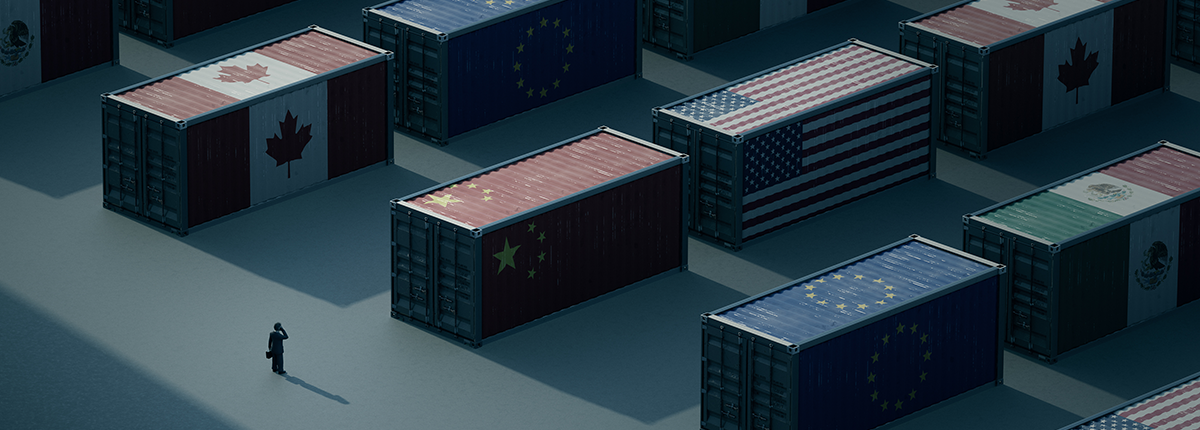Tariffs decoded
Who really pays for trade wars?
By Kevin Manne


Laing

Lindsey

Fotak
Tariffs — the taxes governments impose on imported goods — have historically been used to generate revenue and protect domestic industries from foreign competition.
With tariffs in the national and international spotlight, we asked three experts: Veljko Fotak, associate professor of finance, Charles Lindsey, associate professor of marketing, and Scott Laing, clinical assistant professor of finance, about international trade, globalization and how businesses and consumers can weather uncertainty.
Veljko Fotak: At its core, a tariff is a tax paid by importers to their own government. There’s a misconception that tariffs are absorbed by foreign countries exporting to the U.S., but when tariffs on Chinese imports reached 20% in 2018, foreign exporters only absorbed about 1.5%. The other 18.5% was covered by U.S. importers.
Charles Lindsey: But how much of that cost reaches consumers?
VF: Initially, major retailers absorbed most costs to avoid upsetting customers, resulting in minimal price increases of about 1.5-2%. However, this short-term approach can’t last indefinitely. Retailers operate with thin margins, so prolonged tariffs eventually force price hikes, typically within six months to two years.
Another complication arises when retailers spread tariff-induced price hikes across various products to mitigate customer backlash.
Scott Laing: Tariffs disproportionately affect lower-income consumers. Those living paycheck to paycheck feel the greatest impact because they spend most of their earnings. High-income individuals, whose money largely goes into investments, are less impacted.
CL: Interestingly, recent analysis has shown that lower income consumers are the least stressed, perhaps because they’re less exposed to stock market volatility. However, overall consumer confidence is currently lower than during the Great Recession, nearing pandemic-era levels.
SL: I just think it’s kind of a fruitless venture. The attempt to revive manufacturing via tariffs seems outdated. Manufacturing isn’t our strength anymore. Growing up in Western New York, my friends who worked at the Ford and GM plants found factory work exhausting and undesirable.
CL: Plus, today’s manufacturing relies heavily on robotics, limiting job creation potential.
VF: Tariffs could theoretically revive manufacturing, but it would significantly lower American living standards. Historically, retaliatory tariffs from trading partners reduce U.S. manufacturing output. For instance, the 2018-19 tariffs led to job gains in the steel industry, but caused losses among related suppliers. And this was all subsidized by consumers who paid higher prices.
What does the average consumer see when tariffs go into effect?
SL: Consumers will notice the effect of tariffs on products the U.S. doesn’t produce domestically, such as coffee or bananas. Coffee prices, for example, have nearly tripled recently, partly due to tariffs. Complex products like cars are also significantly impacted because many components are tariffed individually throughout the production chain.
CL: Exactly. To Scott’s point, around 50-60% of components for domestically produced cars come from abroad. Additionally, we import the majority of our fruits and vegetables, so price increases here are noticeable.
VF: Studies indicate that tariffs raised American household costs by $500 to $2,000 annually during the 2018-19 U.S.-China trade war. Newer estimates suggest the cost is closer to $3,000 per household today. Tariffs increase expenses along supply chains, impacting consumer costs directly.
Moreover, the U.S. trade deficit means we rely on foreign investments in our treasury bonds. If global confidence in our financial stability declines, foreign investment drops, causing interest rates to rise sharply. This impacts mortgages, student loans and business borrowing, significantly affecting economic stability.
How do tariffs affect consumer behavior and spending?
CL: Recent data shows increased short-term consumption across multiple categories, suggesting that consumers anticipate further price hikes and are purchasing now. However, long-term, consumers tend to save more and cut back on discretionary spending, such as dining and travel.
SL: Right, and many consumers might not directly link rising prices to tariffs, attributing them instead to broader inflationary trends post-pandemic.
CL: In addition, about half of all spending comes from the top 10% of U.S. earners, who have a better sense of, to Veljko’s point earlier, if these tariffs manifest beyond a certain period of time, prices are going to go up. So they’re purchasing in the short term.
What should business leaders know about tariffs to prepare for future changes?
VF: Uncertainty from tariffs complicates planning. Businesses should maintain higher cash reserves and delay nonessential investments. Companies might consider diversifying their production locations despite losing some efficiencies from economies of scale, because diversified supply chains can help manage tariff risks.
Additionally, leaders should anticipate higher capital costs and lock in long-term financing rates to avoid future spikes.
If you could bust one myth about tariffs, what would it be?
VF: That the U.S. holds the upper hand in a trade war with China. Studies from 2018-19 show Chinese tariffs on U.S. goods were far more effective, as U.S. exports, like soybeans, are easily replaceable by goods from other nations. Conversely, China’s exports to the U.S. include unique, high-tech products with fewer substitutes.
SL: The myth that tariffs will significantly revive U.S. manufacturing jobs. Modern manufacturing relies heavily on automation, and companies have little incentive to relocate operations immediately due to tariffs.
CL: That when consumers buy a domestically produced product that most of that product consists of U.S. parts. It very much depends on the type of product. It’s a complicated world, and there are more supply chain interdependencies than I think the average consumer realizes.


